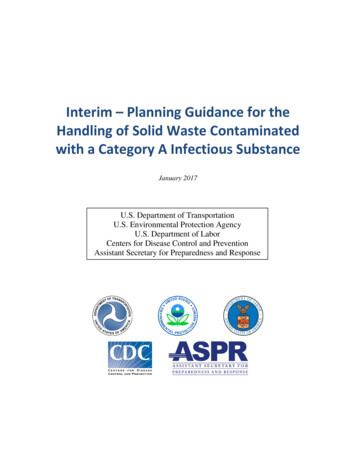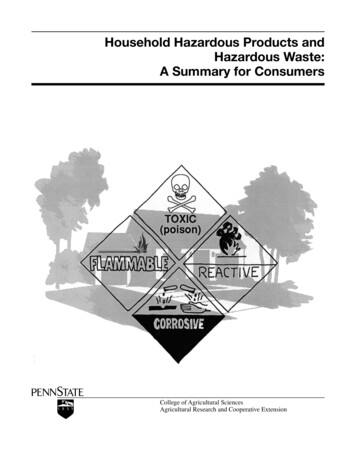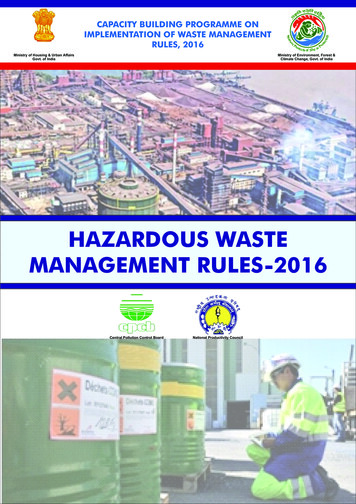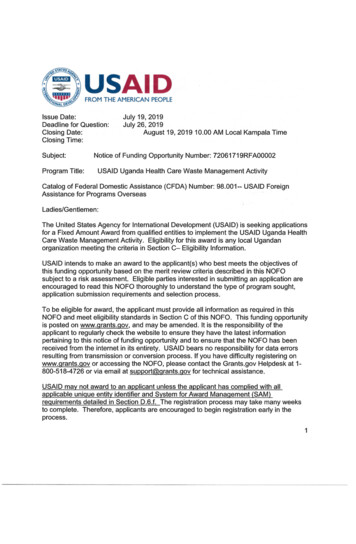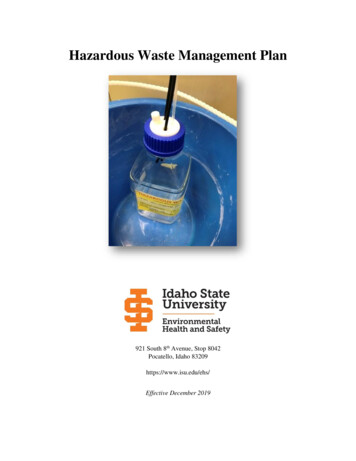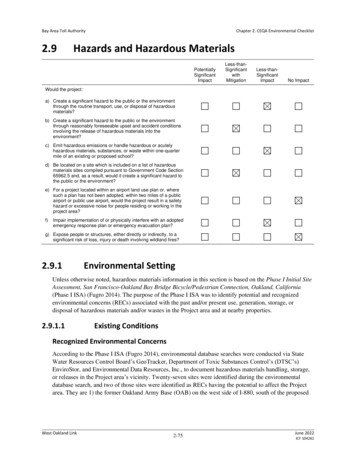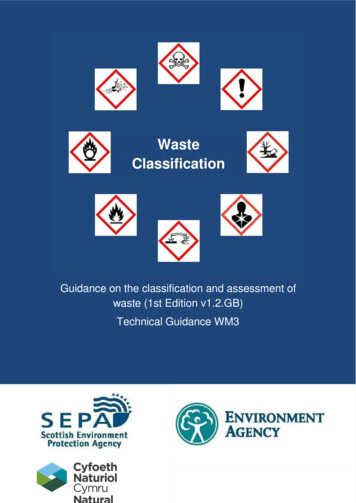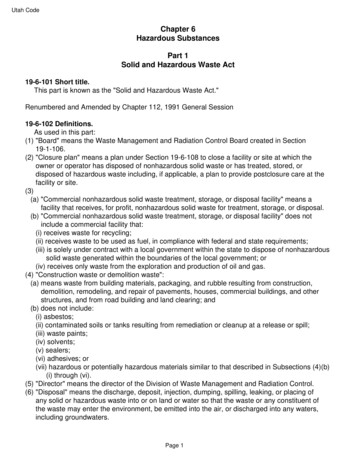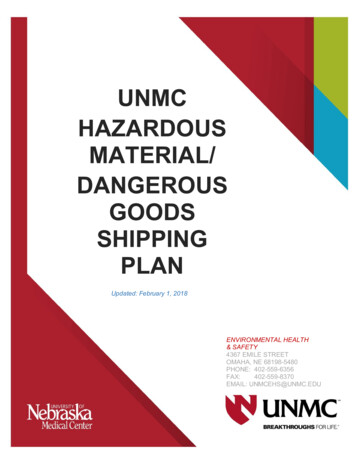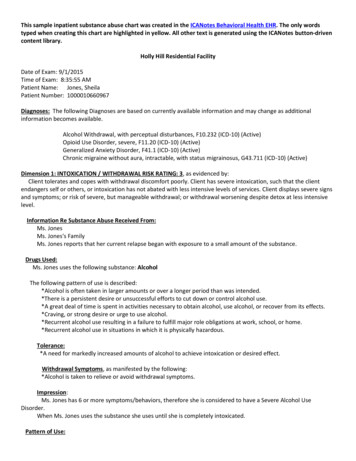
Transcription
Jojoba oil from Simmondsia chinensissc-215204Material Safety Data SheetHazard Alert CodeKey:EXTREMEHIGHMODERATESection 1 - CHEMICAL PRODUCT AND COMPANY IDENTIFICATIONPRODUCT NAMEJojoba oil from Simmondsia chinensisSTATEMENT OF HAZARDOUS NATURECONSIDERED A HAZARDOUS SUBSTANCE ACCORDING TO OSHA 29 CFR 1910.1200.NFPA1FLAMMABILITY0HEALTH HAZARD2INSTABILITYSUPPLIERSanta Cruz Biotechnology, Inc.2145 Delaware AvenueSanta Cruz, California 95060800.457.3801 or 831.457.3800EMERGENCYChemWatchWithin the US & Canada: 877-715-9305Outside the US & Canada: 800 2436 2255(1-800-CHEMCALL) or call 613 9573 3112SYNONYMS"waxes and waxy substances, jojoba", "oil of jojoba", "fixed oil"Section 2 - HAZARDS IDENTIFICATIONCHEMWATCH HAZARD RATINGSMinFlammability1Toxicity0Body Contact2Reactivity2Chronic2MaxMin/Nil 0Low 1Moderate 2High 3Extreme 4CANADIAN WHMIS SYMBOLS1 of 10LOW
EMERGENCY OVERVIEWRISKContact with combustible material may cause fire.POTENTIAL HEALTH EFFECTSACUTE HEALTH EFFECTSSWALLOWED Overexposure is unlikely in this form. The material has NOT been classified as "harmful by ingestion".This is because of the lack of corroborating animal or human evidence. Fatty acid esters have fairly low toxicity.EYE This material can cause eye irritation and damage in some persons.SKIN This material can cause inflammation of the skin oncontact in some persons. The material may accentuate any pre-existing dermatitis condition. Skin contact is not thought to have harmful health effects, however the material may still produce healthdamage following entry through wounds, lesions or abrasions. Open cuts, abraded or irritated skin should not be exposed to this material. Entry into the blood-stream, through, for example, cuts, abrasions or lesions, may produce systemic injury withharmful effects.Examine the skin prior to the use of the material and ensure that any external damage is suitably protected.INHALED The material can cause respiratory irritation in some persons.The body's response to such irritation can cause further lung damage. The material has NOT been classified as "harmful by inhalation".This is because of the lack of corroborating animal or human evidence. Inhalation of oil droplets/ aerosols may cause discomfort and may produce chemical pneumonitis. Fine mists generated from plant/ vegetable (or more rarely from animal) oils may be hazardous.Extreme heating for prolonged periods, at high temperatures, may generate breakdown products which includeacrolein and acrolein-like substances.CHRONIC HEALTH EFFECTS Long-term exposure to respiratory irritants may result in disease of the airways involving difficult breathing andrelated systemic problems.Limited evidence suggests that repeated or long-term occupational exposure may produce cumulative healtheffects involving organs or biochemical systems.Section 3 - COMPOSITION / INFORMATION ON INGREDIENTSNAMECAS RNjojoba oil61789-91-1%being the esters ofC20-C22 straight chain monoethylene acids/ alcohols i.e.eicosenoic acid26764-41-066-77erucic acid112-86-714-20oleic acid112-80-110-132 of 10
Section 4 - FIRST AID MEASURESSWALLOWEDImmediately give a glass of water.First aid is not generally required. If in doubt, contact a Poisons Information Center or a doctor.EYEIf this product comes in contact with the eyesWash out immediately with fresh running water.Ensure complete irrigation of the eye by keeping eyelids apart and away from eye and moving the eyelids byoccasionally lifting the upper and lower lids.SKINIf skin contact occursImmediately remove all contaminated clothing, including footwearFlush skin and hair with running water (and soap if available).INHALEDIf fumes or combustion products are inhaled remove from contaminated area.Lay patient down. Keep warm and rested.NOTES TO PHYSICIAN Treat symptomatically.Section 5 - FIRE FIGHTING MEASURESVapour Pressure (mmHG)Not availableUpper Explosive Limit (%)Not availableSpecific Gravity (water 1)0.8642Lower Explosive Limit (%)Not availableEXTINGUISHING MEDIAFoam.Dry chemical powder.FIRE FIGHTINGAlert Emergency Responders and tell them location and nature of hazard.Wear full body protective clothing with breathing apparatus.GENERAL FIRE HAZARDS/HAZARDOUS COMBUSTIBLE PRODUCTSCombustible.Slight fire hazard when exposed to heat or flame.Combustion products include carbon dioxide (CO2), acrolein, other pyrolysis products typical of burning organicmaterial.May emit poisonous fumes.May emit corrosive fumes.CARE Water in contact with hot liquid may cause foaming and a steam explosion with wide scattering of hot oiland possible severe burns. Foaming may cause overflow of containers and may result in possible fire.FIRE INCOMPATIBILITYAvoid contamination with oxidizing agents i.e. nitrates, oxidizing acids,chlorine bleaches, pool chlorine etc. asignition may result.EXTINGUISHING MEDIAFoam.Dry chemical powder.FIRE FIGHTINGAlert Emergency Responders and tell them location and nature of hazard.Wear full body protective clothing with breathing apparatus.GENERAL FIRE HAZARDS/HAZARDOUS COMBUSTIBLE PRODUCTSCombustible.3 of 10
Slight fire hazard when exposed to heat or flame.Combustion products include carbon dioxide (CO2), acrolein, other pyrolysis products typical of burning organicmaterial.May emit poisonous fumes.May emit corrosive fumes.CARE Water in contact with hot liquid may cause foaming and a steam explosion with wide scattering of hot oiland possible severe burns. Foaming may cause overflow of containers and may result in possible fire.FIRE INCOMPATIBILITYAvoid contamination with oxidizing agents i.e. nitrates, oxidizing acids,chlorine bleaches, pool chlorine etc. asignition may result.Section 6 - ACCIDENTAL RELEASE MEASURESMINOR SPILLSSlippery when spilt.Remove all ignition sources.Clean up all spills immediately.MAJOR SPILLSSlippery when spilt.CARE Absorbent material wet with occluded oil must be wet with water as they may auto-oxidize, become selfheating and ignite.Some oils slowly oxidize when spread in a film and oil on cloths, mops, absorbents may auto-oxidize andgenerate heat, smoulder, ignite and burn. In the workplace oily rags should be collected and immersed in water.Moderate hazard.Clear area of personnel and move upwind.Alert Emergency Responders and tell them location and nature of hazard.Section 7 - HANDLING AND STORAGEPROCEDURE FOR HANDLINGRags wet / soaked with unsaturated hydrocarbons / drying oils may auto-oxidise; generate heat and, in-time,smoulder and ignite. This is especially the case where oil-soaked materials are folded, bunched, compressed, orpiled together - this allows the heat to accumulate or even accelerate the reactionOily cleaning rags should be collected regularly and immersed in water, or spread to dry in safe-place away fromdirect sunlight or stored, immersed, in solvents in suitably closed containers.Avoid all personal contact, including inhalation.Wear protective clothing when risk of exposure occurs.DO NOT allow clothing wet with material to stay in contact with skinRECOMMENDED STORAGE METHODSMetal can or drumPacking as recommended by manufacturer.STORAGE REQUIREMENTSStore in original containers.Keep containers securely sealed.No smoking, naked lights or ignition sources.Store in a cool, dry, well-ventilated area.Store away from incompatible materials and foodstuff containers.Protect containers against physical damage and check regularly for leaks.Observe manufacturer's storing and handling recommendations.Section 8 - EXPOSURE CONTROLS / PERSONAL PROTECTIONEXPOSURE CONTROLS4 of 10
SourceTWA TWASTEL STEL Peak Peak TWANotesppm mg/m³ ppm mg/m³ ppm mg/m³ F/CCMaterialCanada - British Columbia oleic acid (Diesel fuel,Occupational Exposureas total hydrocarbons,LimitsInhalable)100(V)Skinoleic acid (KeroseneCanada - British Columbia/Jet fuels, as totalOccupational Exposurehydrocarbon vapour,LimitsRevised 2003)200(P es with butyl stearate. Fertility, litter size and survival of offspring were normal in rats fed diets containing6.25% butyl stearate for 10 weeks. However, growth was reduced in offspring during the pre-weaning andpost-weaning periods. No gross lesions were noted among the offspring killed at the end of the 21-daypost-weaning periods These results indicate that long-chain fatty acid esters do not cause reproductive toxicity inrats.Given the relative low order of toxicity for long-chain fatty acid esters and their relative non-electrophilic andnon-reactive nature, it seems unlikely that the long-chain fatty acid esters would present serious reproductiveconcerns.Developmental Toxicity/ Teratogenicity. Assessment of developmental effects for the long-chain fatty acid esters inthis group was based primarily on data reported for fatty acid, C16-18, 2-ethylhexyl ester (CAS 91031-48-0). Inoral gavage studies in rats administered doses of 100,300 and 1000 mg/kg during gestation, the maternal NOAELwas 1000 mg/kg and the NOAEL for teratogenicity was 1000 mg/kg. Based on these findings and the factGroup A substances, are very chemically similar to the structure of the tested material, read-across assessment isthought to be appropriate.EICOSENOIC ACIDERUCIC ACID8 of 10
OLEIC ACIDTOXICITYIRRITATIONOral (rat) LD50 74000 mg/kgSkin (human)15 mg/3d-I- ModerateSkin (rabbit)500 mg MildThe material may be irritating to the eye, with prolonged contact causing inflammation. Repeated or prolongedexposure to irritants may produce conjunctivitis.The material may cause skin irritation after prolonged or repeated exposure and may produce on contact skinredness, swelling, the production of vesicles, scaling and thickening of the skin.CARCINOGENoleic acidUS - Rhode Island Hazardous Substance ListIARCSKINoleic acid Canada - British Columbia Occupational Exposure Limits - SkinNotationSkinoleic acid Canada - Alberta Occupational Exposure Limits - SkinSubstance Interaction1Section 12 - ECOLOGICAL INFORMATIONNo dataSection 13 - DISPOSAL CONSIDERATIONSDisposal InstructionsAll waste must be handled in accordance with local, state and federal regulations. Legislation addressing waste disposal requirements may differ by country, state and/ or territory. Each user mustrefer to laws operating in their area. In some areas, certain wastes must be tracked.A Hierarchy of Controls seems to be common - the user should investigate:ReductionReuseRecyclingDisposal (if all else fails)This material may be recycled if unused, or if it has not been contaminated so as to make it unsuitable for itsintended use. If it has been contaminated, it may be possible to reclaim the product by filtration, distillation orsome other means. Shelf life considerations should also be applied in making decisions of this type. Note thatproperties of a material may change in use, and recycling or reuse may not always be appropriate.DO NOT allow wash water from cleaning equipment to enter drains. Collect all wash water for treatment beforedisposal.Recycle wherever possible or consult manufacturer for recycling options.Consult Waste Management Authority for disposal.Section 14 - TRANSPORTATION INFORMATIONNOT REGULATED FOR TRANSPORT OF DANGEROUS GOODS: DOT, IATA, IMDGSection 15 - REGULATORY INFORMATIONjojoba oil (CAS: 61789-91-1) is found on the following regulatory lists;"International Fragrance Association (IFRA) Survey: Transparency List","US Cosmetic Ingredient Review (CIR)Cosmetic ingredients found safe as used","US Toxic Substances Control Act (TSCA) - Chemical SubstanceInventory"Regulations for ingredientseicosenoic acid (CAS: 26764-41-0,5561-99-9) is found on the following regulatory lists;"US DOT Coast Guard Bulk Hazardous Materials - List of Flammable and Combustible Bulk Liquid Cargoes"9 of 10
erucic acid (CAS: 112-86-7) is found on the following regulatory lists;"International Council of Chemical Associations (ICCA) - High Production Volume List","US EPA High ProductionVolume Program Chemical List","US Toxic Substances Control Act (TSCA) - Chemical Substance Inventory"oleic acid (CAS: 112-80-1) is found on the following regulatory lists;"Canada Ingredient Disclosure List (SOR/88-64)","Canada Toxicological Index Service - Workplace HazardousMaterials Information System - WHMIS (English)","GESAMP/EHS Composite List - GESAMP HazardProfiles","IMO IBC Code Chapter 17: Summary of minimum requirements","IMO MARPOL 73/78 (Annex II) - Listof Noxious Liquid Substances Carried in Bulk","International Council of Chemical Associations (ICCA) - HighProduction Volume List","International Fragrance Association (IFRA) Survey: Transparency List","US Pennsylvania - Hazardous Substance List","US - Rhode Island Hazardous Substance List","US CosmeticIngredient Review (CIR) Cosmetic ingredients found safe as used","US DOE Temporary Emergency ExposureLimits (TEELs)","US DOT Coast Guard Bulk Hazardous Materials - List of Flammable and Combustible BulkLiquid Cargoes","US EPA High Production Volume Program Chemical List","US Food Additive Database","USToxic Substances Control Act (TSCA) - Chemical Substance Inventory"Section 16 - OTHER INFORMATIONLIMITED EVIDENCE Cumulative effects may result following exposure*. May produce discomfort of the eyes, respiratory tract and skin*.* (limited evidence).Ingredients with multiple CAS NosIngredient Nameeicosenoic acidCAS26764-41-0, 5561-99-9Reasonable care has been taken in the preparation of this information, but the author makes no warranty ofmerchantability or any other warranty, expressed or implied, with respect to this information. The author makesno representations and assumes no liability for any direct, incidental or consequential damages resulting fromits use. For additional technical information please call our toxicology department on 800 CHEMCALL. Classification of the preparation and its individual components has drawn on official and authoritative sourcesas well as independent review by the Chemwatch Classification committee using available literature references.A list of reference resources used to assist the committee may be found at:www.chemwatch.net/references. The (M)SDS is a Hazard Communication tool and should be used to assist in the Risk Assessment. Manyfactors determine whether the reported Hazards are Risks in the workplace or other settings. Risks may bedetermined by reference to Exposures Scenarios. Scale of use, frequency of use and current or availableengineering controls must be considered.This document is copyright. Apart from any fair dealing for the purposes of private study, research, review orcriticism, as permitted under the Copyright Act, no part may be reproduced by any process without writtenpermission from CHEMWATCH. TEL ( 61 3) 9572 4700.www.chemwatch.netIssue Date: Sep-8-2010Print Date:Oct-4-201110 of 10
Flush skin and hair with running water (and soap if available). INHALED If fumes or combustion products are inhaled remove from contaminated area. Lay patient down. Keep warm and rested. NOTES TO PHYSICIAN Treat symptomatically. Section 5 - FIRE FIGHTING MEASURES Vapour Pressure (mmHG) Not available Upper Explosive Limit (%) Not available
